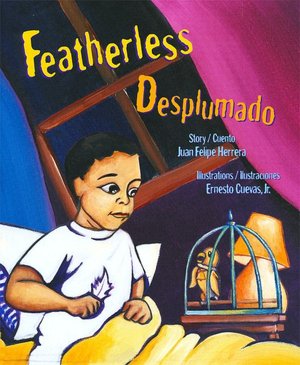
Related Information
|
Comments
| |
Name
of Book:
|
Keep
Your Ear on the Ball
| |
Author
|
Genevieve
Petrillo
| |
Illustrator
|
Lea
Lyon
| |
Publisher
|
Tilbury
House, Publishers
| |
Year
of Pub:
|
2007
| |
ISBN:
|
978-0-88448-296-3
| |
Age
range
|
6-10
(or even older)
| |
Type
of Disability
|
Blindness
| |
Fiction
or Nonfiction
|
Fiction
| |
Category: B
A)books that provide factual information about a disability
B) books that provide information
about a disability in a story format in which the character with a disability
is integral to the plot
C) books that provide stories that
have a character with a disability who may or may not be integral to the
storyline and who has been added to the story to achieve diversity and
reflect reality
|
||
Annotation
Davey
is the new kid in class. He’s typical in every way, except that he is blind. Eager
to assist Davey in any way they can, the other students ask whether they can
help him get around and complete the activities. But Davey, determined to
show them he can do everything himself, gives the same answer every
time: “Thanks, but no thanks.” They
get the hint and stop asking how they can help him. But during recess, it’s
time to play kickball, and Davey keeps missing the ball or running into
people. Nobody wants him on the team. The kids’ moods are low until one of
them comes up with a plan. Through
innovation and determination, they provide Davey with the tools he needs to
play the game. And most important, Davey is able to maintain his independence
and dignity AND learn how to accept what others have to offer. Vivid,
realistic, portrait-like illustrations.
| ||
Link
to publisher:
| ||
Links to professional reviews:
| ||
Awards:
| ||
Standards for Quality Portrayal
of Characters with a disability
|
Comments
| |
1.
Promotes empathy not pity
|
Yes
| |
2.
Promotes acceptance, not ridicule
|
Yes
| |
3.
Emphasizes success rather than, or in addition to failure
|
Yes
| |
4.
Promotes positive images of persons with disabilities or illness
|
Yes
| |
5.
Assists children in gaining accurate understanding of the disability or
illness
|
Yes
|
The
book jacket provides information about the real person who was the
inspiration for the character (David DeNotaris) and about assistive technology
used today by students with visual impairments.
|
6.
Demonstrates respect for persons with disabilities or illness
|
Yes
| |
7.
Promotes attitude of “one of us” not
“one of them.”
|
Yes
|
Especially
so!
|
8.
Uses people-first language
|
Yes
| |
9.
Describes the disability or person with disabilities or illness as realistic
(not subhuman or superhuman)
|
Yes
| |
10.
Depicts people with disabilities as more similar to than different from other
people
|
Yes
|
Absolutely.
|
11.
Shows peoples’ strengths and abilities along with their disabilities
|
Yes
| |
12.
Represents characters as strong, independent people who others can admire or
learn from
|
Yes
|
The
illustrations play a major role here.
|
13.
Represents people with disabilities from different racial and cultural
backgrounds, religions, age groups, and sexual orientations
|
No
|
Character
is white. Classmates are culturally diverse.
|
14.
Shows people with disabilities in integrated settings and activities
|
Yes
| |
15.
Shows people with disabilities in valued occupations and diverse roles.
|
Yes
| |
16.
Shows people with disabilities in reciprocal relationships
|
Yes
| |
17.
Main character develops and grows emotionally as a result of what happens in
the story
|
Yes
|
This
is a main point of the book.
|
Watch
for an interview with the illustrator, Lea Lyon!
